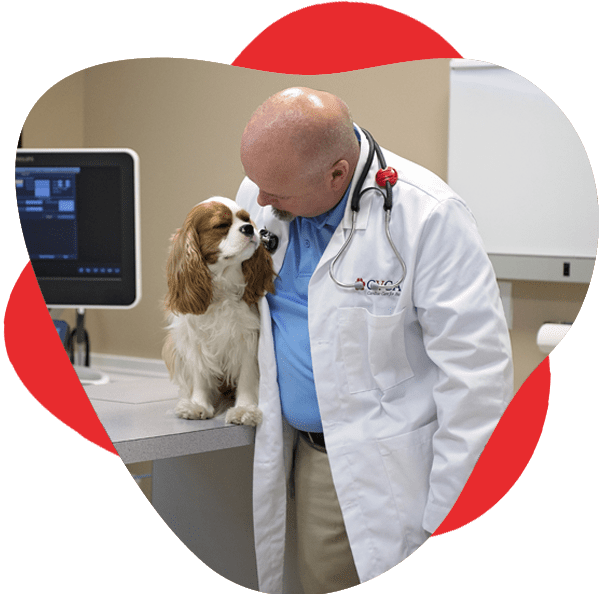What You Required to Find Out About Veterinary Providers: An Introduction of Diagnostic Tools and Procedures
Vet solutions play an essential function in maintaining the wellness of pets. Routine check-ups can disclose concealed health issues early. Numerous analysis devices and procedures, such as blood examinations and imaging strategies, provide vital understandings into a pet's wellness. Comprehending these methods is crucial for pet dog owners. What details analysis treatments are most generally utilized, and just how can they influence an animal's treatment plan?
Significance of Routine Vet Check-Ups
While numerous family pet owners might ignore the significance of normal veterinary examinations, these visits are important for keeping a pet's total health. Routine check outs to the vet enable very early discovery of potential health and wellness issues prior to they rise right into serious troubles. Regular exams often include vaccinations, which are essential for avoiding infectious conditions that might severely influence a pet's health. Additionally, these visits give a chance for vets to examine the pet's weight, oral wellness, and general problem, ensuring that the family pet is thriving. Throughout these visits, family pet owners can likewise get useful advice on diet, workout, and preventative treatment tailored to their specific pet dog's needs.
Common Analysis Treatments in Vet Medication
In veterinary medication, precise diagnosis is essential for reliable therapy. Usual analysis treatments consist of blood screening strategies, advanced imaging modern technologies, and urinalysis, each playing a significant role in recognizing health concerns. Recognizing these methods enhances the capacity to provide appropriate take care of pet individuals.
Blood Checking Strategies
Blood testing techniques act as necessary analysis tools in vet medicine, making it possible for vets to analyze the health and wellness of animals properly. These techniques include accumulating blood examples to examine different elements, such as white and red blood cells, platelets, and biochemical pens. Typical examinations include full blood counts (CBC), which evaluate total wellness and discover infections, and biochemical panels, which evaluate body organ function and metabolic status. Furthermore, serological tests can recognize specific conditions via antibody discovery. Blood screening is minimally invasive and gives important details that helps in detecting problems, keeping track of wellness status, and examining feedbacks to treatments. Overall, these methods play an essential duty in making sure ideal look after pet dogs and livestock alike.
Imaging Technologies Utilized
Diagnostic imaging innovations are essential tools in veterinary medication, enhancing blood screening techniques by offering visual understandings right into a pet's inner structures. Common imaging techniques consist of X-rays, which serve for assessing bone fractures and discovering international things, and ultrasound, which enables real-time visualization of soft cells and organs. Magnetic resonance imaging (MRI) uses in-depth images of complex anatomical areas, especially in neurological assessments. Calculated tomography (CT) provides cross-sectional pictures, improving diagnostic precision for different conditions. Each of these modern technologies help vets in detecting ailments, intending therapies, and checking recovery. By including imaging technologies, veterinary experts can better analyze a pet's health and wellness and make educated choices concerning their care.
Urinalysis and Diagnostics
Urinalysis acts as a critical analysis device in veterinary medicine, providing beneficial understandings into a pet's overall health and wellness and helping in the detection of various conditions. This non-invasive procedure analyzes pee examples to evaluate kidney function, hydration standing, and metabolic conditions. Common components checked out consist of particular gravity, pH degrees, glucose, proteins, and the presence of blood or microorganisms. Abnormal findings can show issues such as urinary system system infections, diabetes mellitus, or kidney condition. To improve analysis precision, urinalysis is usually executed in combination with various other examinations, such as blood job and imaging studies. Early discovery with urinalysis can result in prompt treatments, enhancing the diagnosis for numerous veterinary individuals. For that reason, it is a vital element of thorough veterinary care.
Understanding Blood Tests and Lab Evaluation
Comprehending blood tests and lab analysis is crucial in vet medication as it aids in diagnosing various health conditions in pets. Various kinds of blood tests supply important info concerning a pet's inner state, while analyzing lab results requires cautious consideration of numerous variables. This section will certainly discover the sorts of blood tests offered and the value of their results.
Sorts Of Blood Tests
Blood tests play an essential role in veterinary medicine, supplying crucial insights into an animal's health and wellness condition. Numerous sorts of blood examinations are used, each offering different functions. Complete blood counts (CBC) assess total wellness and identify problems such as anemia or infection. Biochemical accounts assess body organ feature by gauging enzymes and electrolytes, providing insights into metabolic health. Serological tests identify details antibodies or microorganisms, assisting in the diagnosis of infections or autoimmune illness. Blood inputting guarantees risk-free transfusions, while coagulation tests determine the blood's ability to clot, vital for surgeries. These tests collectively enhance diagnosis, treatment planning, and surveillance of a pet's health, showing the importance of thorough research laboratory evaluation in veterinary care.

Interpreting Laboratory Results
A complete evaluation of laboratory outcomes is vital for exact diagnosis and therapy in veterinary medicine. Analyzing lab results needs an understanding of normal reference arrays and the relevance of discrepancies. Blood examinations can disclose numerous health and wellness indicators, such as body organ function, electrolyte balance, and the presence of infections. Vets should take into consideration the entire clinical picture, including the animal's history, health examination findings, you could try these out and any type of signs presented. Variants in results may arise from aspects such as age, type, and underlying wellness conditions. Laboratory results ought to not be seen in seclusion yet rather as part of a comprehensive analysis technique. Accurate analysis enables for tailored treatment plans and better end results for vet clients.
Imaging Techniques: X-rays, Ultrasounds, and Beyond
Imaging techniques are important devices in vet medicine, offering crucial insights right into the health and well-being of pets. Among one of the most typically utilized approaches are X-rays and ultrasounds. X-rays are indispensable for imagining bone structures, aiding vets determine fractures, lumps, or international items. This technique is non-invasive and quick, making it ideal for immediate situations.Ultrasounds, on the other hand, utilize acoustic waves to create pictures of soft tissues and organs. This strategy is especially valuable for taking a look at the heart, abdomen, and reproductive organs, permitting veterinarians to examine problems like liquid buildup or organ abnormalities.Beyond X-rays and ultrasounds, progressed imaging techniques such as computed tomography (CT) and magnetic resonance imaging (MRI) are increasingly made use of in veterinary practice. These approaches supply thorough cross-sectional photos, boosting the precision of diagnoses and treatment plans. Ultrasound For Dogs. Generally, imaging strategies play an essential duty in ensuring reliable veterinary care
The Role of Biopsies in Diagnosing Family Pet Health Issues
Precision in identifying wellness issues in family pets commonly pivots on making use of biopsies, which offer conclusive details regarding cells irregularities. A biopsy entails the elimination of a tiny example of cells for assessment under a microscopic lense, permitting vets to recognize numerous problems, consisting of infections, lumps, and inflammatory conditions. This diagnostic device is crucial for comparing malignant and benign growths, directing treatment decisions, and evaluating the severity of a condition.Biopsies can be carried out using different methods, such as needle goal, incisional biopsies, or excisional biopsies, depending upon the area and kind of tissue entailed. The choice of approach might influence recovery time and the quantity of cells gathered. Inevitably, the information obtained from a biopsy can lead to targeted treatments, improving outcomes for pets dealing with significant health and wellness obstacles. Vets stress the importance of this treatment in accomplishing precise diagnoses and reliable treatment plans.
Advanced Diagnostic Devices: Endoscopy and CT Checks

Advanced diagnostic tools, such as endoscopy and CT scans, play a crucial function in contemporary vet medicine, providing non-invasive methods to picture inner frameworks and identify different problems in animals. Endoscopy includes making use of a flexible tube equipped with a video camera, allowing vets to take a look at the stomach system and breathing system straight. This technique can expose problems such as tumors, foreign bodies, or swelling, enabling targeted therapy plans.CT scans, on the other hand, use innovative imaging technology to produce in-depth cross-sectional pictures of the body (Cancer Veterinary Near Me). This technique is specifically helpful for reviewing complex frameworks like the mind, spinal column, and joints. By giving high-resolution images, CT scans help vets in identifying issues that may not be obvious with standard radiography. With each other, these innovative devices boost diagnostic accuracy, enhance treatment end results, and inevitably add to better total pet dog health monitoring

Analyzing Test Outcomes: What Pet Owners Must Know
Understanding examination results can be a difficult task for animal proprietors, specifically after sophisticated procedures like endoscopy and CT scans have actually been executed. Translating these outcomes requires a grasp of clinical terminology and a clear understanding of what the searchings for suggest regarding the family pet's wellness. Veterinarians usually offer descriptions, yet the complexity of the outcomes can still cause confusion.Pet owners must actively take part in discussions with their veterinarians, asking questions to clarify any type of uncertainties. It is vital to understand uncommon versus regular results and the implications for the pet dog's therapy plan. Furthermore, acknowledging that some results might require more testing or surveillance can aid proprietors remain notified about their family pet's wellness trip. Ultimately, a collective technique between animal proprietors and veterinary professionals fosters much better health end results and enhances the general care experience for pet dogs.
Regularly Asked Concerns
How Do I Pick the Right Vet Facility for My Animal?
Picking the appropriate vet facility entails investigating neighborhood alternatives, examining credentials, checking out centers, and This Site analyzing team communications (Cancer Veterinary Near Me). Focusing on recommendations from trusted resources can aid ensure the finest treatment and environment for a pet's health demands
What Should I Do if My Family Pet Declines to head to the Veterinarian?
When a pet rejects to visit the vet, it's advisable to continue to be calm, usage deals with or toys to tempt them, and consider arranging a home go to if stress and anxiety lingers. Perseverance and positive support are vital.
Exist Telehealth Options for Veterinary Solutions?
Telehealth alternatives for veterinary services are increasingly available, enabling animal owners to seek advice from veterinarians remotely. These solutions allow conversations about health and wellness worries, guidance on small conditions, and follow-ups without needing to see a facility.
Just how Typically Should My Pet Dog Have Oral Exams?
The regularity of oral check-ups for pet dogs normally depends upon their age and type. Normally, vets recommend yearly dental evaluations, although some animals might require more constant sees to maintain ideal dental wellness.

What Are the Expenses Connected With Vet Diagnostics?
The prices connected with vet diagnostics can differ commonly, typically varying from standard examinations like blood work to advanced imaging techniques. Elements influencing expenses consist of the here facility's location, equipment used, and particular tests needed for each pet dog. Vet solutions play a vital duty in maintaining the health and wellness of pets. While many animal proprietors may ignore the relevance of normal veterinary examinations, these appointments are essential for maintaining an animal's overall wellness. Additionally, these appointments provide an opportunity for vets to analyze the pet's weight, oral health, and general problem, guaranteeing that the animal is flourishing. Precision in detecting health concerns in pet dogs usually hinges on the use of biopsies, which offer definitive details regarding cells problems. Additionally, identifying that some outcomes may call for more testing or monitoring can aid owners stay educated concerning their family pet's health trip.